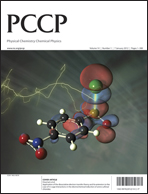Simple Carbenes as Hydrogen-Bond Acceptors: Nucleophilicities and Reduced Nucleophilicities determined ab initio
IF 2.9
3区 化学
Q3 CHEMISTRY, PHYSICAL
引用次数: 0
Abstract
Nucleophilicities for a range of simple carbenes molecules acting as hydrogen-bond acceptors B in forming complexes BHX are reported. The carbenes chosen to fulfil the roles of Lewis base are: B = R2M, cyclo-(CH)2M, H2C=C=M and two N-heterocyclic carbenes, where M is one of the Group 14 tetrel atoms C, Si, Ge or Sn and R = H, CH3, F. All the carbenes but CH2 have a singlet electronic ground state. The Lewis acids HX involved are HF, HCl, HBr, HI and HCN, HCCH, HCP. Nucleophilicities NB of the carbenes were determined graphically from equilibrium dissociation energies De for the process BHX = B + HX by using the equation De = c.NB.EHX, where c =1.0 kJ mol-1 and the EHX are known numerical electrophilicities of the Lewis acids HX. De values were calculated ab initio at the CCSD(T)-F12c/ cc-pVDZ-F12 level of theory, that for CH2 referring to the singlet electronic excited state. It was established that NR2M values lie in the order M = C >> Si ~ Ge ~ Sn for a given R and in the order R = CH3 > H > F for a given M. Reduced nucleophilicities NB/σaxial were determined by using the molecular electronic surface potential σaxial at the atom M (which lies on the C2 axis) on the 0.001 e/bohr3 iso-surface of each carbene molecule, as calculated at the MP2/aug-cc-pVTZ level. For R2M having R =CH3 and H and cyclo-(CH)2-M carbenes, the determined values of NB/σaxial are shown to be independent of R and M.作为氢键受体的简单烯碳化合物:亲核力和还原亲核力的初始测定
报告了一系列简单碳烯分子在形成络合物 BHX 时作为氢键受体 B 的亲核性。被选为路易斯碱的碳烯分子有B = R2M、环-(CH)2M、H2C=C=M 和两个 N-杂环碳烯,其中 M 是第 14 组四原子 C、Si、Ge 或 Sn 之一,R = H、CH3、F。涉及的路易斯酸 HX 有 HF、HCl、HBr、HI 和 HCN、HCCH、HCP。碳烯的亲核性 NB 是根据 BHX = B + HX 过程的平衡解离能 De 以图形方式确定的,计算公式为 De = c.NB.EHX,其中 c =1.0 kJ mol-1,EHX 是路易斯酸 HX 的已知亲电数值。De 值是在 CCSD(T)-F12c/ cc-pVDZ-F12 理论水平上计算的,CH2 的 De 值是指单线电子激发态。还原亲核力 NB/σaxial 是通过在每个碳烯分子的 0.001 e/bohr3 等离子表面上使用原子 M(位于 C2 轴上)处的分子电子表面势 σaxial 确定的,计算结果在 MP2/aug-cc-pVTZ 水平上进行了计算。对于 R =CH3 和 H 的 R2M 以及环-(CH)2-M 碳烯,NB/σaxial 的确定值与 R 和 M 无关。
本文章由计算机程序翻译,如有差异,请以英文原文为准。
求助全文
约1分钟内获得全文
求助全文
来源期刊

Physical Chemistry Chemical Physics
化学-物理:原子、分子和化学物理
CiteScore
5.50
自引率
9.10%
发文量
2675
审稿时长
2.0 months
期刊介绍:
Physical Chemistry Chemical Physics (PCCP) is an international journal co-owned by 19 physical chemistry and physics societies from around the world. This journal publishes original, cutting-edge research in physical chemistry, chemical physics and biophysical chemistry. To be suitable for publication in PCCP, articles must include significant innovation and/or insight into physical chemistry; this is the most important criterion that reviewers and Editors will judge against when evaluating submissions.
The journal has a broad scope and welcomes contributions spanning experiment, theory, computation and data science. Topical coverage includes spectroscopy, dynamics, kinetics, statistical mechanics, thermodynamics, electrochemistry, catalysis, surface science, quantum mechanics, quantum computing and machine learning. Interdisciplinary research areas such as polymers and soft matter, materials, nanoscience, energy, surfaces/interfaces, and biophysical chemistry are welcomed if they demonstrate significant innovation and/or insight into physical chemistry. Joined experimental/theoretical studies are particularly appreciated when complementary and based on up-to-date approaches.
 求助内容:
求助内容: 应助结果提醒方式:
应助结果提醒方式:


